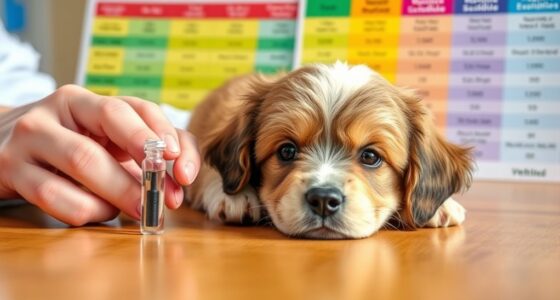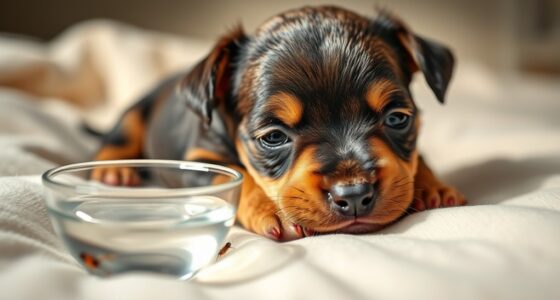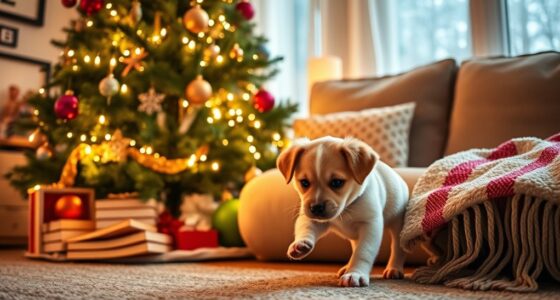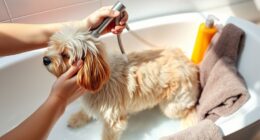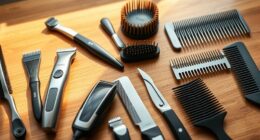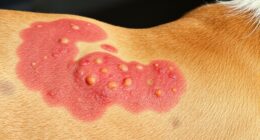To make certain your new puppy’s health and happiness, set up a cozy, safe space with familiar items, establish a feeding routine with high-quality food, and schedule regular vet visits for vaccinations and health checks. Start house training early using consistent routines, supervise outdoor bathroom breaks, and praise good behavior. Gather essential supplies like toys and grooming tools, socialize your pup gradually, and keep training positive and patient. To get all the key steps, continue exploring this essential puppy checklist.
Key Takeaways
- Set up a designated, cozy space with familiar items to ensure your puppy feels safe and secure.
- Establish a consistent feeding and potty routine to promote house training and healthy growth.
- Gather essential supplies like a collar, leash, toys, grooming tools, and schedule veterinary visits.
- Begin socialization early by introducing your puppy to different people, environments, and other pets.
- Use positive reinforcement and short training sessions to build good behavior and trust.
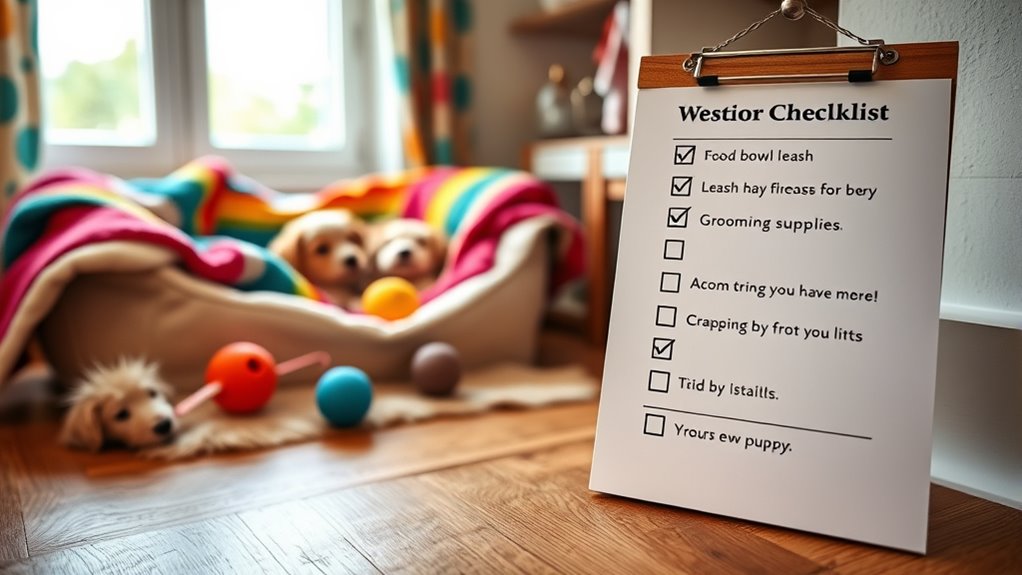
Getting a new puppy is exciting, but it also requires careful preparation to guarantee a smooth changeover for your new furry friend. The first step is setting up a safe, comfortable space where your puppy can feel secure. This includes choosing a designated area with a cozy bed, placing familiar items like toys and blankets nearby. Having a dedicated space helps your puppy adjust more easily and reduces stress. As you prepare, focus on puppy nutrition. Selecting high-quality puppy food ensures your pup gets the right nutrients for growth and development. Consult your veterinarian to find the best diet and establish a feeding schedule. Consistent meal times help regulate your puppy’s digestion and make house training routines smoother. Remember, puppies often need to eat three to four times daily, so plan accordingly. Keep fresh water accessible at all times to keep your puppy hydrated and healthy. Incorporating proper nutrition and balanced meals can support your puppy’s immune system and overall health. When it comes to house training routines, patience and consistency are key. Start by establishing a routine for bathroom breaks, taking your puppy outside frequently—especially after meals, naps, and play sessions. Use a specific spot outside for them to do their business, and always praise or reward them when they go in the right place. This positive reinforcement builds good habits and speeds up training. Be prepared for accidents; if your puppy has a mishap indoors, calmly clean it up without punishment, and avoid scolding. Crate training can be an effective part of house training routines, providing your puppy with a safe space and helping to control their bladder. Remember, puppies have small bladders and need frequent bathroom breaks, so patience is essential as they learn. Along with nutrition and house training, you’ll want to gather essential supplies like a collar, leash, toys, grooming tools, and cleaning supplies. Regular veterinary visits are critical to monitor your puppy’s health, ensure they’re up to date on vaccinations, and get personalized advice. Socialization is equally important—introduce your puppy to different people, environments, and other pets gradually to build confidence and prevent behavioral issues later. Establishing a routine early on helps your puppy understand what to expect and fosters trust. Keep training sessions short, positive, and consistent to maintain your puppy’s interest and reinforce good behavior. By combining proper puppy nutrition and well-structured house training routines with patience and love, you’ll set a strong foundation for a healthy, happy life together.
Frequently Asked Questions
How Do I Introduce My Puppy to Other Pets Safely?
When introducing your puppy to other pets, you should follow socialization tips to guarantee a safe, positive experience. Start by introducing them in a neutral, new environment to reduce territorial behavior. Keep initial interactions brief, calmly supervise, and gradually increase time together. Use positive reinforcement to reward good behavior, and watch for signs of stress or aggression. This approach helps your puppy build confidence and fosters healthy relationships with your other pets.
What Are Signs of Common Puppy Health Issues?
You should watch for signs of common puppy health issues like lethargy, vomiting, diarrhea, or loss of appetite. Regular puppy vaccination helps prevent serious diseases, while noticing signs of common parasites such as fleas or worms is essential. If your puppy shows any of these symptoms, consult your vet promptly. Early detection and treatment ensure your puppy stays healthy and happy as they grow.
How Can I Puppy-Proof My Home Effectively?
Your home is a potential minefield of hazards—puppy-proofing safety is essential. Start by securing household hazards like electrical cords, small objects, and toxic plants. Use baby gates to block off dangerous areas and keep chemicals out of reach. Remember, puppies are like little detectives exploring everything, so double-check every nook and cranny. With thorough pet proofing, you create a safe space, preventing accidents and giving your puppy the best start in life.
When Should I Start Training Basic Commands?
You should start training basic commands as soon as you bring your puppy home. Early socialization is vital during the 3 to 14-week window, so incorporate potty training and simple commands like sit and stay right away. Consistent, positive reinforcement helps your puppy learn quickly. The sooner you begin, the better your puppy will respond, making socialization timing and potty training more effective in the long run.
What Are the Best Toys for Teething Puppies?
Think of teething puppies as tiny explorers discovering new territories. To keep them happy and prevent destructive habits, you need the right tools—puppy teething chew toys are like treasure chests filled with comfort. Opt for durable, safe options like rubber or nylon toys, which soothe sore gums and satisfy their natural urge to chew. These toys help your pup explore safely while protecting your belongings.
Conclusion
So, there you have it—your foolproof, no-escape puppy checklist. Now, go ahead, plunge into the chaos, embrace the puppy breath, and pretend you’re not already planning a puppy funeral after the first chewed shoe. Remember, every nap, squeak toy, and misadventure is just part of the grand puppy saga. Buckle up, enjoy the ride, and maybe, just maybe, you’ll survive to brag about it later. Happy puppy parenthood!




